FM Steve Stoyko – NM Scott Massey
Round 10
King’s Indian Defense [E94]
Kenilworth Chess Club Championship, Kenilworth, NJ
USA
March 24,
2005
Annotated by Michael Goeller, based on comments by
the participants
1.d4 d6 2.c4
Nf6 3.Nc3 g6 4.e4 Bg7 5.Nf3 0–0
6.Be2 e5 7.0–0 exd4
More common is
7…Nc6 8.d5 Ne7 leading to the Mar del Plata variation,
where the book variations can run to 30 moves or more.
Scott realized that Steve would have had an
edge in those lines.
8.Nxd4 Re8 9.f3 Nbd7 10.Be3 Nc5
11.b4 Ne6
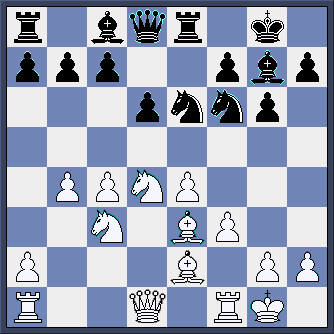
Position after 11….Ne6
12.Rc1!
Getting the Rook off of the
vulnerable a1–h8
diagonal and protecting the potentially loose Knight
at c3. White also has ambitions of opening the c-file
or advancing the c-pawn supported by the Rook. Stoyko
points out that 12.Qd2?! is “practically a blunder” due
to 12…Nxd4! 13.Bxd4 c5!= with easy equality.
12…Bd7
13.Nb3
White avoids exchanges and prepares to support
his Queenside attack.
13…b6
Black fights for control
of c5 but creates potential weaknesses on the light
squares — especially c6. Now on Nd5 Black will not
be able to exchange without opening the c-file by cxd5,
giving White tremendous pressure on the critical pawn
at c7.
14.Qd2 Bc6 15.Nd5 Nd7 16.Nd4
White
has such a dominant position that he can consider opening
up on the Kingside with 16.f4!? (threatening f5) 16…Nef8
17.Bf3 (17.Nd4!?) 17…Bb7 18.a4 and White has gained
a lot of space.
16…Bb7 17.Rfd1 a5 18.a3 axb4 19.axb4
Ra3?!
Creating potential exchange threats against the
Bishop at e3 while considering the idea of doubling
on the a-file. But the Rook is soon driven back. Perhaps
better 19…Be5!
a) 20.f4?! Bxd4 21.Bxd4 Nxd4
22.Qxd4 c5! 23.bxc5 bxc5 24.Qd3 Bxd5 25.cxd5 (25.Qxd5
Nf6!) 25…Qe7=
b) 20.Bf2!? c5!
c) 20.Nxe6 fxe6 21.Bg5
Qb8 (21…Nf6 22.Nxf6+ Bxf6 23.Bxf6 Qxf6 24.c5 +=)
22.Ne3!? Qa7!? unclear
20.Bf2
The immediate 20.Nb5! Rb3!?
21.Rc2 leaves the Rook precariously placed but may
be less clear.
20…Ndf8
Black may have to try something
like 20…Be5!? 21.Nb5 Rb3!? Now White ge ts a tremendous
queenside initiative with a piece sacrifice that
creates powerful passed pawns.

Position after 21….Ra8
21.Nb5! Ra8 22.Ndxc7!!
Nxc7 23.Bxb6 Nfe6 24.Nxd6!
Also worth considering
was 24.Bxc7 Nxc7 25.Nxd6 Rf8 26.c5! (but not 26.Nxb7?!
Qxd2 27.Rxd2 Bh6 28.Rcd1 Bxd2 29.Rxd2 Rfb8 30.Nd6
Rxb4 unclear)
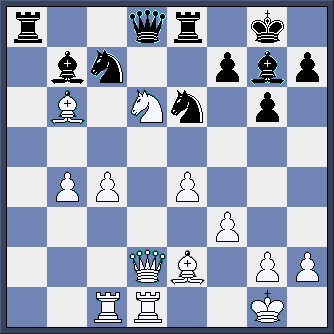
Position after 24.Nxd6
24…Qb8!?
Scott gives up the exchange,
perhaps with the idea of using the b8-h2 diagonal
to create some threats against White’s King. Stoyko
thought the best try was 24…Re7!? 25.c5! (again
if 25.Nxb7?! Qxd2! 26.Rxd2 Bh6! 27.Rcd1 Bxd2 28.Rxd2
Ra1+! 29.Kf2 Na8! 30.Be3 Rxb7 unclear, and
it is tough to believe that the pawns are worth a
Rook, though Fritz seems to think so) 25…Qb8 26.f4!
and White’s attack continues but the position seems
more balanced.
25.Nxe8 Nxe8 26.Be3! Be5 27.h3 N8g7
28.b5 Nh5 29.c5 Bh2+ 30.Kf1
Not
30.Kh1?? Ng3+ 31.Kxh2
Nxe4+winning the Queen. But now Scott uncorks a surprising
sacrifice.
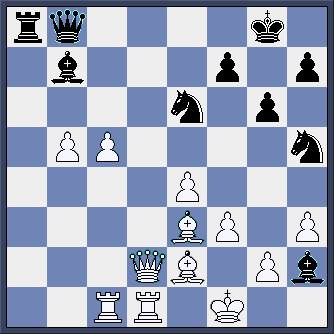
Position after 30.Kf1
30…Bxe4!
A fascinating idea, which
Scott seems to have considered practically desperation
, since he played it mostly on intuition. Though White
should probably still win, the move creates many chances
for him to go wrong.
31.Ra1?!
This gets White into
some troubles, though only in ways that a computer
might figure out. After the game, Scott and Steve
looked at accepting the Bishop sacrifice by 31.fxe4
Ng3+ 32.Ke1 (32.Kf2?? Nxe4+–+)
32…Nxe4 33.Qd3 Qg3+ 34.Kf1 Qh4!! 35.Bg4 (35.Rd2 Rd8!)
35…Ng3+ 36.Ke1 Ra2!! and Black’s threats look terrible.
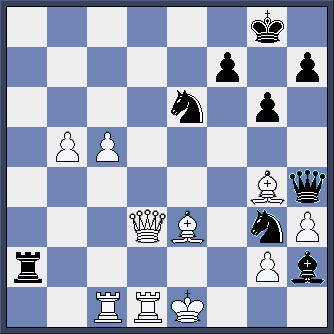
Possible position if Steve
takes the Bishop sac,
after 36….Ra2!!
Fritz and Junior suggest a likely
draw, however, after 37.Rc2! Ne4+! (37…Rxc2!?) 38.Kf1!
(38.g3!? Qxg3+ 39.Kf1 N4xc5! unclear) 38…Ng3+ = with
perpetual check. I’m sure it just did not look appealing
to Stoyko, who no doubt rejected it intuitively after
examining a few lines.
Steve was therefore correct to decline
the sacrifice, but the best way was by pushing his
pawns: 31.c6! Ng3+ 32.Ke1 Nxe2 33.Qxe2 Bf5 34.b6!
+- and the pawns should triumph here.
In any event, 31.Ra1?! is not best.
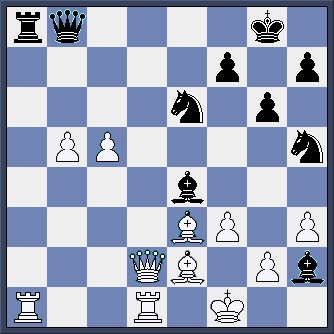
Position after 31.Ra1?!
31…Rxa1?!
Black
misses an important finesse in first 31…Ng3+! 32.Ke1
(32.Kf2? Nh1+!! = since 33.Rxh1?? Qg3+ 34.Kf1 Rxa1+ –+)
32…Rxa1 33.Rxa1 Nxe2 34.Qxe2 (34.fxe4? Be5 35.Ra3
N2d4)
34…Qe5 and Black’s initiative seems to be
enough for at least a draw: 35.Ra4 (35.Ra3 Nd4 36.Bxd4
Qxd4 37.fxe4 Qb4+ 38.Qd2 Qxa3 39.Qd8+ Kg7 40.Qd4+ =)
35…Nxc5! 36.Bxc5 Bg3+ 37.Kd2 Qb2+ 38.Ke3 Bf4+ 39.Kf2
Bg3+ 40.Ke3 Bf4+ =
32.Rxa1 Be5
This position is quite complicated and Black seems
to have a lot of counterplay. Worth considering is
32…Qe5!? 33.Ra4!? (33.Rc1 Ng3+ 34.Ke1 (34.Kf2 Nf5
unclear) 34…Bf5 35.Qc3! unclear)
33…Ng3+ 34.Kf2 Nxc5 35.Rc4 Nb7 unclear
33.Ra4 Ng3+
34.Kf2?!
To guarantee the win, White must play
34.Kg1! Bc3 35.Qd1 Bd5!? (35…Bb7 36.c6
Qe5 37.Qd3) 36.Qxd5! (36.c6?! Qe5!) 36…Nxe2+
37.Kf2 Qg3+ 38.Kxe2 Qe1+ 39.Kd3 Qd1+ 40.Kc4 Qxa4+ 41.Kxc3
Qa5+!? 42.Kd3 Qxb5+ 43.Kc3± and White’s extra
pawn gives him a winning ending.
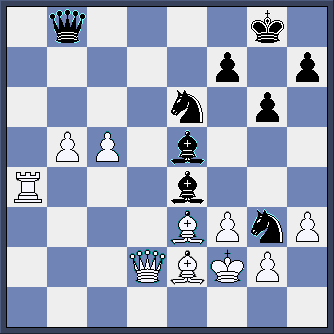
Position after 34.Kf2?!
34…Bf5?
The losing
move! Hard as it is to believe, Black could likely
still equalize with 34…Nxe2!
a) 35.Qxe2 Bc6!
36.Rb4 (36.bxc6?! Bg3+ 37.Kg1 Qb1+ 38.Qf1 Bh2+ 39.Kxh2
Qxf1 40.Bh6 f6 41.Ra8+ Kf7 42.Ra7+ Ke8 43.Ra8+ =) 36…Nc7!?=
b) 35.Rxe4 Nc3! 36.Rxe5 Qxe5 37.b6
Na4 38.c6 Nxb6! 39.Bxb6 Qb5! =
35.Qd5! Nxe2
36.Ra8 N2f4 37.Rxb8+ Bxb8 38.Bxf4 Bxf4 39.b6 +-
and Black lost on
time….
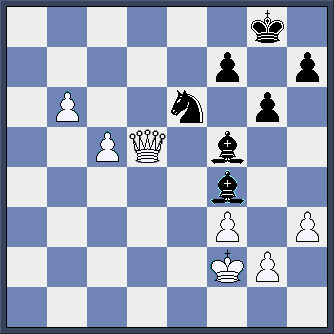
Final position after 39.b6!
For pictures of the participants,
see the Photos section of the site.
1–0
Updated 3-28-2005 |
Contact Michael
Goeller